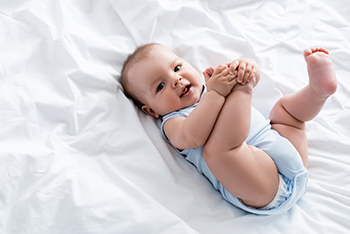
Polydactyly is a congenital foot defect where a child is born with extra fingers or toes. The name comes from a combination of Greek words, “poly” for many and “dactylos” for digits. There are different types of polydactyly of the feet. The most frequent form is an extra toe next to the fifth toe. The extra digit can be complete and fully functional or partially formed with some bone. It can also present as a small mass of soft tissue. When polydactyly occurs without other abnormalities, it is referred to as isolated or non-syndromic polydactyly. When there is another genetic condition present, such as a cognitive and developmental abnormality, it is called syndromic polydactyly. This condition tends to be hereditary and can occur from genetic mutations and environmental reasons. The left foot is most often affected and is twice as common among males. Treatment for polydactyly is dependent on where the extra toe is. Surgery to remove the extra toe is frequently done in the first two years of a child’s life to allow typical use of the foot and a better ability to fit into shoes. If you have a baby born with polydactyly, it is strongly suggested that you take them to a podiatrist as soon as possible who can consult with you on the best way to treat this condition.
Congenital foot problems require immediate attention to avoid future complications. If you have any concerns, contact one of our podiatrists of Jill Einhorn, DPM and James Einhorn, DPM. Our doctors can provide the care you need to keep you pain-free and on your feet.
Congenital foot problems are deformities affecting the feet, toes, and/or ankles that children are born with. Some of these conditions have a genetic cause while others just happen. Some specific foot ailments that children may be born with include clubfeet, polydactyly/macrodactyly, and cleft foot. There are several other foot anomalies that can occur congenitally. What all of these conditions have in common is that a child may experience difficulty walking or performing everyday activities, as well as trouble finding footwear that fits their foot deformity. Some of these conditions are more serious than others. Consulting with a podiatrist as early as possible will help in properly diagnosing a child’s foot condition while getting the necessary treatment underway.
What are Causes of Congenital Foot Problem?
A congenital foot problem is one that happens to a child at birth. These conditions can be caused by a genetic predisposition, developmental or positional abnormalities during gestation, or with no known cause.
What are Symptoms of Congenital Foot Problems?
Symptoms vary by the congenital condition. Symptoms may consist of the following:
Treatment and Prevention
While there is nothing one can do to prevent congenital foot problems, raising awareness and receiving neonatal screenings are important. Early detection by taking your child to a podiatrist leads to the best outcome possible.
If you have any questions please feel free to contact our offices located in Brooklyn and Astoria, NY . We offer the newest diagnostic tools and technology to treat your foot and ankle needs.